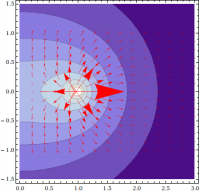You are here: start » book » physics » ering1hint
Wrap-Up: Electric Field due to a Ring
In § {Activity: Electric Field due to a Ring}, you will have found an integral expression for the electric field due to a uniform ring of charge, then used power series methods to approximate the integral in various regions. This activity has much in common with § {Activity: A Uniformly Charged Ring}, which you may want to review at this time. In addition to the ideas discussed in the wrap-up to that activity in § {Wrap-Up: A Uniformly Charged Ring}, you may have needed to pay attention to some of the following:
- You can only integrate vectors using rectangular basis vectors which are constant and therefore pull through the integral. It is fine and even preferable, however, to use curvilinear coordinates for the scalar parts of the integral.
- Make sure to keep track of the difference between primed and unprimed variables, knowing which are changing at each step of the computation.
- When expanding the integrand in the plane of the ring, the “small” quantity with respect to which you need to expand may consist of the sum of two terms, such as $\epsilon=2\frac{R}{r}\cos\phi'+\frac{R^2}{r^2}$. There is nothing wrong with this, but you may not have seen it before. When you truncate the series to a specific order, you will need to expand out powers of $\epsilon$ and only keep the appropriate powers in the expansion.
- In equation (1) of § {Potentials from Continuous Charge Distributions} the charge density is described as a volume charge density. You must change this equation to accommodate a line charge. Thus, the equation \begin{eqnarray*} \EE(\rr) = \Int_{\hbox{ring}} {1\over 4\pi\epsilon_0} {\rho(\rrp)\,(\rr-\rrp)\,d\tau'\over|\rr-\rrp|^3} \end{eqnarray*} becomes \begin{eqnarray*} \EE(r, \phi, z) = {\lambda\over 4\pi\epsilon_0} \Int_0^{2\pi} {\left((r\cos\phi-R\cos\phi')\ii+(r\sin\phi-R\sin\phi')\jj+z\,\kk\right) R\,d\phi'\over\left({r^2+R^2-2rR\cos(\phi-\phi')+z^2}\right)^{3/2}} \end{eqnarray*}
You can check your work using the Mathematica notebook
$\qquad\qquad\qquad\qquad$ Electric Field of a Continuous Ring
which was used to construct Figure 1.
